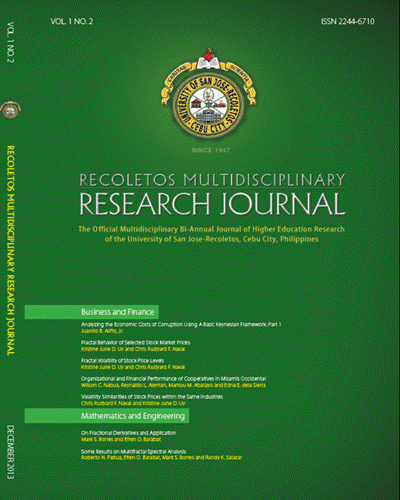On Fractional Derivatives and Application
DOI:
https://doi.org/10.32871/rmrj1301.02.06Keywords:
local approximation, global approximation, fractional derivativesAbstract
In many instances, the first derivative of the functional representation f(x) will fail to exist (Mandelbrot, 1987). When this happens, it is important to develop an appropriate language to describe these minute finer roughness and irregularities of the geometric objects. This paper attempts to develop the calculus of fractional derivatives for this purpose. Local approximations to functional values by fractional derivatives provide finer and better estimate than the global approximations represented by power series e.g Mclaurin’s series. Fractional derivatives incorporate information on the fluctuations and irregularities near the true functional values, hence, attaining greater precision.
References
(2nd ed.). Springer-Verlag. doi:10.1007/3-540-33099-2. ISBN 978-3-540-33098-1.
Cherlin, Greg (1976). Model Theoretic Algebra Selected Topics. Lecture Notes in Mathematics 521. Springer-Verlag. ISBN 978-3-540-07696-4.
Cutkosky, Steven Dale (2004). Resolution of Singularities. Graduate Studies in Mathematics 63. American Mathematical Society. ISBN 0-8218-3555-6.
Eisenbud, David (1995). Commutative Algebra with a View Toward Algebraic Geometry. Graduate Texts in Mathematics 150. Springer-Verlag.ISBN 3-540-94269-6.
Kedlaya, KiranSridhara (2001). “The algebraic closure of the power series field in positive characteristicâ€. Proc. Amer. Math. Soc. 129: 3461–
3470.doi:10.1090/S0002-9939-01-06001-4
Newton, Isaac (1760). “letter to Oldenburg dated 1676 Oct 24â€. The correspondence of Isaac Newton II. Cambridge University press. pp. 126–127. ISBN 0-521-08722-8
Newton, Isaac (1736). The method of fluxions and infinite series; with its application to the geometry of curvelines (translated from Latin and published by John Colson in 1736)
Solomentsev, E.D. (2001), “Power seriesâ€, in Hazewinkel, Michiel, Encyclopedia of Mathematics, Springer, ISBN 978-1-55608-010-4
Downloads
Published
How to Cite
Issue
Section
License
Copyright of the Journal belongs to the University of San Jose-Recoletos


